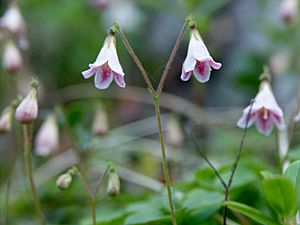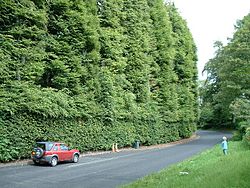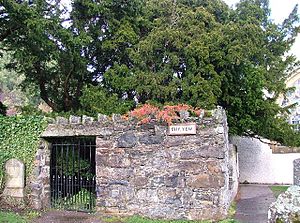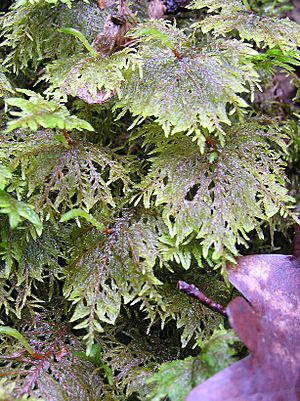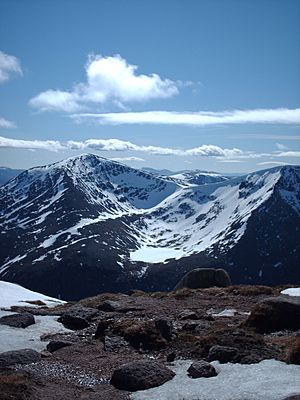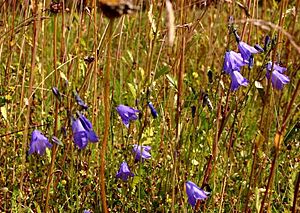Flora of Scotland facts for kids
The flora of Scotland is all the different kinds of plants that grow naturally in Scotland. This includes over 1,600 types of plants with stems and leaves, more than 1,500 types of lichens, and nearly 1,000 types of bryophytes (like mosses and liverworts). While Scotland doesn't have a huge number of vascular plants compared to some other parts of the world, it has many lichens and bryophytes, which are very important globally.
Scotland is also home to some rare ferns. However, in the 1800s, plant collectors almost made some of these species disappear! The plants in Scotland are similar to those found in other parts of northwest Europe. You'll find boreal Caledonian forests (though much smaller now), heather moorlands, and coastal machair (a special type of grassland). Besides native plants, many non-native plants have been brought to Scotland, making up about 43% of all species.

Scotland has some very important and unique trees. A Grand Fir in Argyll is the tallest tree in the United Kingdom, and the Fortingall Yew might be the oldest tree in Europe! Some flowering plants, like the Arran Whitebeams, Shetland Mouse-ear, and Scottish Primrose, are endemic, meaning they are found only in Scotland. There are also unique mosses and lichens. People in Scotland care a lot about protecting nature, and many groups work to look after the country's plants. You'll also find many stories, songs, and poems about Scotland's plants.
Contents
Plant Homes: Habitats in Scotland
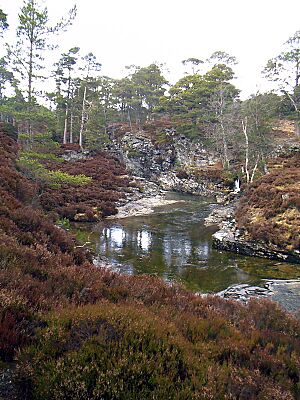
Scotland has many different types of natural environments, called habitats. These include deciduous (trees that lose their leaves) and coniferous (evergreen) woodlands, moorlands, mountain areas, river mouths, freshwater lakes and rivers, and coastal areas.
About 14% of Scotland is covered by trees, but much of this is from planted forests. Long ago, there were much larger areas of native boreal Caledonian and broad-leaved forests. You can still find important parts of the native Scots Pine woodlands today.
Seventeen percent of Scotland is covered by heather moorland and peatland. Caithness and Sutherland have some of the biggest and best-preserved areas of blanket bog in the world, which are home to special wildlife. Most of Scotland's land (75%) is used for farming.
Scotland has almost 800 islands with plants, and about 600 of them are off the west coast. It also has a lot of fresh water – over 90% of the UK's fresh water volume and 70% of its surface area! There are more than 30,000 freshwater lochs (lakes) and 6,600 river systems.
Below the tree line, you'll find different types of forests. Birch trees are common in the west and north. Scots Pine grows with Birch and oak in the eastern Highlands. In the Central Lowlands and Borders, you'll see oak (both Quercus robur and Q. petrea) with Birch.
A lot of Scotland's coastline has machair. This is a special, fertile grassland formed after the last ice age. Machairs are very important because they have unique ecosystems.
Flowering Plants and Shrubs
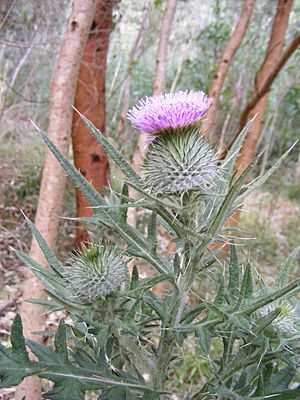
Scotland doesn't have as many types of vascular plants as some other places. This is partly because of the Pleistocene ice ages, which wiped out most plants, and the creation of the North Sea, which made it hard for new plants to arrive. Still, Scotland has many important and interesting plant species.
Heather moorland is very common. It contains plants like Ling, Bell Heather, Cross-leaved Heath, Bog Myrtle, and fescue grasses. You can also find smaller flowering plants like Cloudberry and Alpine Ladies-mantle here.
Cliffs and mountains are home to many arctic and alpine plants. These include Alpine Pearlwort, Mossy Cyphal, Mountain Avens, and Fir Clubmoss. On the Hebridean islands, you'll find "plantago pastures" that grow well in salty sea spray. These include Red Fescue, Sea Plantain, and Sea Pink.
Machair landscapes have rare species like Irish Lady's Tresses, Yellow Rattle, and many orchids. More common plants there are Marram grass, Buttercup, Ragwort, Bird's-foot Trefoil, and Ribwort Plantain. Scots Lovage and the Oyster Plant are common along the coasts.
Aquatic Plants
Bogbean and Water Lobelia are often found in moorland pools and small lochs. The Least (Nuphar pumila), Yellow, and White Water-lilies are also common.
Pipewort (Eriocaulon aquaticum) is an interesting plant. It was first found on the Skye in the 1700s. This plant is common in North America but very rare in Europe, only growing in Scotland and western Ireland. You can also find a few examples of the Rigid Hornwort (Ceratophyllum demersum).
Grasses and Sedges
Grasses and sedges grow almost everywhere in Scotland, except on sand dunes (where marram grass is common) and rocky mountain tops. There are many different types of grasses and sedges. For example, 84 species have been found along just one road in West Lothian.
Smooth Meadow-grass and Broad-leaved Meadow-grass are common in damp lowlands. Wood Sedge (Carex sylvatica) grows in woodlands, and Oval Sedge and Early Hair-grass are found on upland moors. In wet areas, you'll see Phragmites reeds and several types of Juncus (rushes). These include Jointed Rush, Soft Rush, and Toad Rush. The introduced Slender Rush is less common.
Common Cottongrass is easy to spot in marshy areas. However, Saltmarsh Sedge (Carex salina) was only discovered in Scotland for the first time in 2004 at the head of Loch Duich.
Endemic Species
An "endemic" plant is one that is found only in a specific area and nowhere else in the world.
The Shetland Mouse-ear (Cerastium nigrescens) is an endemic plant found only in Shetland. It was first recorded in 1837. Today, it grows only on two special serpentine hills on the island of Unst.
The Scottish Primrose (Primula scotica) is endemic to Scotland's north coast, including Caithness and Orkney. It is related to Arctic plants.
Young's Helleborine (Epipactis youngiana) is a rare endemic orchid. It is mainly found on waste heaps from the coal-mining industry in the Central Lowlands. It is considered endangered.
The St Kilda Dandelion (Taraxacum pankhurstianum) is a type of dandelion found only on the island of Hirta. It was identified in 2012.
Rare Species
Some of Scotland's flowering plants are found in very few places. These include Diapensia lapponica, which grows only on the slopes of Sgurr an Utha in Argyll. Mountain Bearberry is found in only a few mainland spots, and on Skye and Orkney.
The pine forests of Strathspey have rare species like Creeping Lady's Tresses, Twinflower, and the One-flowered Wintergreen. Plans were made in 2008 to protect the Intermediate Wintergreen, which also grows here.
Other rare plants in Scotland include Tufted Saxifrage, Alpine Catchfly, Sword-leaved Helleborine, Norwegian Sandwort, Dark-red Helleborine, Iceland Purslane, Small Cow-wheat, and Yellow Oxytropis.
Invasive Plants
Some non-native plants have been brought to Scotland and are now causing problems for native plants. These are called "invasive species." Examples include Giant Hogweed, Japanese Knotweed, and Rhododendron. These plants can spread quickly and take over habitats, harming native biodiversity.
In 2008, scientists considered bringing tiny psyllid lice from Japan to the UK to help control Japanese Knotweed. This would be the first time an alien species was used in Britain for this purpose. Scientists believe the lice will not harm the environment.
Another problem is too much grazing by Red Deer and sheep. This has damaged moorland and upland habitats and reduced native woodlands.
Deciduous Trees
Only 31 types of deciduous trees and shrubs are native to Scotland. These include 10 types of willows, four types of whitebeams, and three types of birch and cherry trees.
The Meikleour Beech hedges in Perth and Kinross were planted in 1745. This European Beech hedge is 530 meters (0.3 miles) long and 30 meters (100 ft) tall. It is listed in the Guinness World Records as the tallest and longest hedge on Earth!
The Arran Whitebeams are unique trees found only on the Isle of Arran. The Arran Whitebeam (Sorbus arranensis) and the Cut-leaved Whitebeam (S. pseudofennica) are among the most endangered tree species in the world because there are so few of them. In 1980, only 236 mature S. pseudofennica and 283 S. arranensis trees were counted. These trees developed in a special way, involving the Rock Whitebeam (S. rupicola) from nearby Holy Isle mixing with the Rowan (S. aucuparia) to create new species. In 2007, two examples of a third new hybrid, the Catacol Whitebeam (S. pseudomeinichii), were found on Arran. This tree is a mix of the native Rowan and S. pseudofennica.
Shakespeare wrote about Birnam Wood being used as camouflage for Malcolm Canmore’s army before a battle with MacBeth. There is an old tree, the Birnam Oak, near Birnam. It might have been part of Birnam Wood 900 years ago and is now part of the legend.
Scientists have also looked into using Sea Buckthorn for commercial purposes. Its orange berries can be made into jams, drinks, and ointments. This tough plant grows well even on exposed coasts.
Conifers
The Scots Pine and Common Juniper are the only coniferous trees definitely native to Scotland. Yew trees might also be native.
The Fortingall Yew is a very old tree in a churchyard in Fortingall, Perthshire. People have estimated its age to be between 2,000 and 5,000 years old. Recent studies suggest it's probably closer to 2,000 years. Even so, it's still the oldest tree in Europe!
A Grand Fir planted near Loch Fyne, Argyll, in the 1870s, was named the UK’s tallest tree in 2011, standing at 64.3 meters (211 ft). The next four tallest trees in the UK are also in Scotland. The Stronardron Douglas Fir near Dunans Castle in Argyll is 63.79 meters (209.3 ft) tall. Diana’s Grove Grand Fir at Blair Castle is 62.7 meters (205.7 ft). Dùghall Mòr (Scottish Gaelic for "big dark stranger"), another Douglas Fir near Inverness, is over 62 meters (203 ft) tall. It was once thought to be the tallest in Britain. The Hermitage Douglas Fir near Dunkeld is 61.31 meters (201.1 ft) tall.
Ferns
Bracken is very common in upland areas. Beech Fern grows in woods and shady spots, and Scaly Male Fern is found in wooded or open areas. Wilsons Filmy-fern is common in the Highlands, along with the Tunbridge Filmy-fern, Alpine Lady-fern, and the rarer Newman’s Lady-fern (A. distentifolium var. flexile), which is only found in Scotland. The Killarney Fern, once thought to be gone from Scotland, has been found on Skye in its gametophyte form (a stage in its life cycle).
Scotland's populations of Alpine Woodsia and Oblong Woodsia are at the edge of their natural ranges. Alpine Woodsia is found only in Angus, Perthshire, Argyll, and north Wales. Oblong Woodsia is found in Angus, the Moffat Hills, north Wales, and two places in England. These ferns were nearly wiped out by Victorian fern collectors in the mid-1800s. Cystopteris dickieana, first found in a sea cave in Kincardineshire, is a rare fern in the UK, found only in Scotland.
Non-Vascular Plants
Scotland is a great place for many bryophyte species (mosses and liverworts). This is because of the damp climate, no long dry spells, and mild winters. Also, Scotland's varied geology, rocky areas, and deep, damp ravines, along with clean air, allow many different species to thrive. This makes Scotland's bryophyte collection very special, especially compared to its native vascular plants.
There are about 920 species of moss and liverwort in Scotland. This means Scotland has 87% of the UK's bryophytes and 60% of Europe's! Scotland's bryophyte flora is important globally, with this small country possibly hosting 5% of the world’s species. The mountains of the North-west Highlands have a unique bryophyte community called the "Northern Hepatic Mat," which has many rare liverworts like Pleurozia purpurea and Anastrophyllum alpinum.
Scotland has also been important in studying bryology (the study of bryophytes). Pioneers like Archibald Menzies and Sir William Hooker started exploring here in the late 1700s. Tetrodontium brownianum is named after Robert Brown, who first found it near Roslin. Other species like Plagiochila atlantica and Anastrepta orcadensis were also first discovered in Scotland.
Mosses
Sphagnum moss is common and is even harvested for hanging baskets, wreaths, and medical uses. Glittering Wood-moss, Woolly Hair-moss (Racomitrium lanuginosum), and Bristly Haircap (Polytrichum piliferum) are other common native mosses.
Endemic moss species include the Scottish Thread-moss, Dixon’s Thread Moss, and Scottish Beard-moss. In the Cairngorms, you can find small patches of Snow Brook-moss and Alpine Thyme-moss. There's also a lot of Icy Rock-moss, which in the UK is found only here and at one site in England. The west coast has many oceanic mosses like Cyclodictyon laetevirens. The Ben Lawers mountain range also has rare species like Tongue-leaved Gland Moss. Perthshire Beard-moss is a European endemic, found at only four other sites in Europe outside Scotland, and it is considered "Critically Endangered."
Liverworts and Hornworts
There are many common liverworts like Conocephalum conicum and Marchantia polymorpha. Autumn Flapwort (Jamesoniella autumnali), a rare species usually found in oak woods in western Scotland, was discovered on Ben Lomond in 2008. This species is named after Scottish botanist William Jameson. Northern prongwort is an endemic liverwort found only in the Beinn Eighe nature reserve. The high Cairngorms have other unusual liverworts, including Marsupella arctica, which in Europe is found only here and in Svalbard.
Hornworts are rare in Scotland. For example, Carolina Hornwort (Phaeoceros carolinianus) has only been found in Lauderdale.
Lichens
Lichens are very common in Scotland. About 37% of all European lichen species are found here, even though Scotland is only 0.75% of Europe's land area. Most rock surfaces, unless they are very exposed or always wet, are covered with lichens. Reindeer Moss (Cladonia rangiferina) is a common type. The trunks and branches of large trees are important homes for lichens, with Tree Lungwort being very noticeable. In the past, lichens were often used to dye clothes.
Graphis alboscripta and Halecania rhypodiza are endemic lichen species. The first is found in the hazel woodlands of the west coast, and the second at only two sites in the Highlands. The Cairngorm Mountains are home to 35 species of lichens that are found nowhere else in Britain. These include Alectoria ochroleuca, Rinodian parasitica, and Cladonia trassii. Other rare lichens found here are Jamesiella scotica, Cladonia botrytes, and Ramalina polymorpha.
Protecting Scotland's Plants
Protecting nature is very important in the United Kingdom. Several government organizations help look after Scotland's plants. Scottish Natural Heritage is the main group responsible for managing natural heritage in Scotland. One of their jobs is to create National Nature Reserves. As of 2006, there were 55 of these reserves. Forestry and Land Scotland is the forestry department of the Scottish Government and owns a lot of land. The Joint Nature Conservation Committee advises the government on nature conservation for the whole UK and internationally.
Scotland has two national parks. Cairngorms National Park has the largest area of arctic mountain landscape in the UK. Many areas important for nature, covering 39% of Scotland's land, are protected here. Two-thirds of these areas are important across Europe. Loch Lomond and the Trossachs National Park includes Britain's largest freshwater lake, the mountains of Breadalbane, and the sea lochs of Argyll.
Many charities and volunteer groups also help protect Scotland's plants. The National Trust for Scotland is the largest conservation charity in Scotland, with over 270,000 members. It protects and promotes Scotland's natural and cultural heritage. The Royal Society for the Protection of Birds helps birds and other wildlife by protecting and creating habitats. The John Muir Trust looks after wild land and wildlife, owning land and promoting education about conservation. They manage estates in places like Knoydart, Assynt, and on the Isle of Skye. Trees for Life is a charity that aims to bring back a "wild forest" in the Northwest Highlands and Grampian Mountains.
Under the European Union's Habitats Directive, by March 2003, the UK government had suggested 230 sites in Scotland, covering 8,748.08 square kilometers (3,377.65 sq mi), to be Special Areas of Conservation (cSAC).
The Wildlife and Countryside Act 1981 makes it illegal to dig up plants without the landowner's permission. It also protects the most threatened species, listed in Schedule 8, making it illegal to collect any part of them. In 2012, the Scottish Government released a "Code of Practice on Non-Native Species" to help people understand how to deal with invasive plants.
Plants in Scottish Culture
Plants are a big part of Gaelic and Scottish folklore, songs, and poems.
The thistle has been a national symbol of Scotland since the time of King Alexander III (1249–1286). It was even used on silver coins by King James III in 1470. Today, it's part of the emblem of the Scottish Rugby Union.
Legend says that an invading army tried to sneak up on the Scots at night. One soldier, perhaps barefoot, stepped on a Scottish Thistle and cried out in pain. This alerted the Scots to their presence. Some stories say this happened at the Battle of Largs, which led to the departure of the Viking king Haakon IV of Norway. Thorny plants like brambles have been used around forts for a long time, so this story might be a mix of different events over time.
Many plants are mentioned in Scottish songs and poems. These include Robert Burns' A Red, Red Rose, Sorley MacLean's Hallaig, Harry Lauder's I Love A Lassie, and Runrig's And The Accordions Played. The last two mention the "bluebell." The "Scottish Bluebell" is Campanula rotundifolia (also known as the "Harebell"), not the Common Bluebell.
Trees were very important in Gaelic culture from ancient times. Very large trees were respected. Valuable trees like oak, Common Hazel, and Apple were called "nobles." Less important trees like Common Alder, Common Hawthorn, and Gean were "commoners." There were also "lower orders" and "slaves" like Eurasian Aspen and Juniper. The Gaelic alphabet was even learned using tree names. Rowan trees were often planted near Highland houses to protect against witchcraft.
Various plants are believed to have special powers to ward off evil, especially the Mountain Ash.



